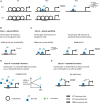Transcriptional precision in photoreceptor development and diseases - Lessons from 25 years of CRX research
- PMID: 38414750
- PMCID: PMC10896975
- DOI: 10.3389/fncel.2024.1347436
Transcriptional precision in photoreceptor development and diseases - Lessons from 25 years of CRX research
Abstract
The vertebrate retina is made up of six specialized neuronal cell types and one glia that are generated from a common retinal progenitor. The development of these distinct cell types is programmed by transcription factors that regulate the expression of specific genes essential for cell fate specification and differentiation. Because of the complex nature of transcriptional regulation, understanding transcription factor functions in development and disease is challenging. Research on the Cone-rod homeobox transcription factor CRX provides an excellent model to address these challenges. In this review, we reflect on 25 years of mammalian CRX research and discuss recent progress in elucidating the distinct pathogenic mechanisms of four CRX coding variant classes. We highlight how in vitro biochemical studies of CRX protein functions facilitate understanding CRX regulatory principles in animal models. We conclude with a brief discussion of the emerging systems biology approaches that could accelerate precision medicine for CRX-linked diseases and beyond.
Keywords: CRX; dominant diseases; gene regulation; homeodomain; inherited retinopathy; molecular genetics; pathogenic mechanisms.
Copyright © 2024 Zheng and Chen.
Conflict of interest statement
The authors declare that the research was conducted in the absence of any commercial or financial relationships that could be construed as a potential conflict of interest.
Figures



Similar articles
-
Aberrant homeodomain-DNA cooperative dimerization underlies distinct developmental defects in two dominant CRX retinopathy models.bioRxiv [Preprint]. 2024 Mar 14:2024.03.12.584677. doi: 10.1101/2024.03.12.584677. bioRxiv. 2024. Update in: Genome Res. 2025 Feb 14;35(2):242-256. doi: 10.1101/gr.279340.124. PMID: 38559186 Free PMC article. Updated. Preprint.
-
Missense mutations in CRX homeodomain cause dominant retinopathies through two distinct mechanisms.Elife. 2023 Nov 14;12:RP87147. doi: 10.7554/eLife.87147. Elife. 2023. PMID: 37963072 Free PMC article.
-
Missense mutations in CRX homeodomain cause dominant retinopathies through two distinct mechanisms.bioRxiv [Preprint]. 2023 Jun 15:2023.02.01.526652. doi: 10.1101/2023.02.01.526652. bioRxiv. 2023. Update in: Elife. 2023 Nov 14;12:RP87147. doi: 10.7554/eLife.87147. PMID: 36778408 Free PMC article. Updated. Preprint.
-
Cone Rod Homeobox (CRX): literature review and new insights.Ophthalmic Genet. 2025 Mar 12:1-9. doi: 10.1080/13816810.2025.2458086. Online ahead of print. Ophthalmic Genet. 2025. PMID: 40074530 Review.
-
Mechanisms of blindness: animal models provide insight into distinct CRX-associated retinopathies.Dev Dyn. 2014 Oct;243(10):1153-66. doi: 10.1002/dvdy.24151. Epub 2014 Jun 27. Dev Dyn. 2014. PMID: 24888636 Free PMC article. Review.
Cited by
-
Aberrant homeodomain-DNA cooperative dimerization underlies distinct developmental defects in two dominant CRX retinopathy models.Genome Res. 2025 Feb 14;35(2):242-256. doi: 10.1101/gr.279340.124. Genome Res. 2025. PMID: 39715683 Free PMC article.
-
Pharmaceutical inhibition of the Chk2 kinase mitigates cone photoreceptor degeneration in an iPSC model of Bardet-Biedl syndrome.iScience. 2025 Mar 1;28(4):112130. doi: 10.1016/j.isci.2025.112130. eCollection 2025 Apr 18. iScience. 2025. PMID: 40151639 Free PMC article.
-
Top2b-Regulated Genes and Pathways Linked to Retinal Homeostasis and Degeneration.Cells. 2025 Jun 12;14(12):887. doi: 10.3390/cells14120887. Cells. 2025. PMID: 40558514 Free PMC article. Review.
-
Active DNA demethylation is upstream of rod-photoreceptor fate determination and required for retinal development.bioRxiv [Preprint]. 2025 Feb 3:2025.02.03.636318. doi: 10.1101/2025.02.03.636318. bioRxiv. 2025. Update in: PLoS Biol. 2025 Aug 4;23(8):e3003332. doi: 10.1371/journal.pbio.3003332. PMID: 39975078 Free PMC article. Updated. Preprint.
-
Aberrant homeodomain-DNA cooperative dimerization underlies distinct developmental defects in two dominant CRX retinopathy models.bioRxiv [Preprint]. 2024 Mar 14:2024.03.12.584677. doi: 10.1101/2024.03.12.584677. bioRxiv. 2024. Update in: Genome Res. 2025 Feb 14;35(2):242-256. doi: 10.1101/gr.279340.124. PMID: 38559186 Free PMC article. Updated. Preprint.
References
-
- Aavani T., Tachibana N., Wallace V., Biernaskie J., Schuurmans C. (2017). Temporal profiling of photoreceptor lineage gene expression during murine retinal development. Gene Expr. Patterns 23 32–44. - PubMed
Publication types
Grants and funding
LinkOut - more resources
Full Text Sources
Research Materials

